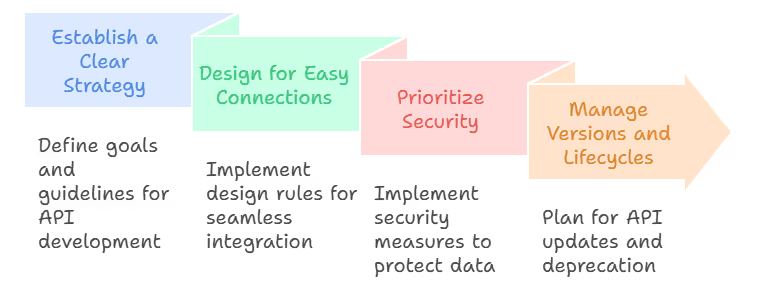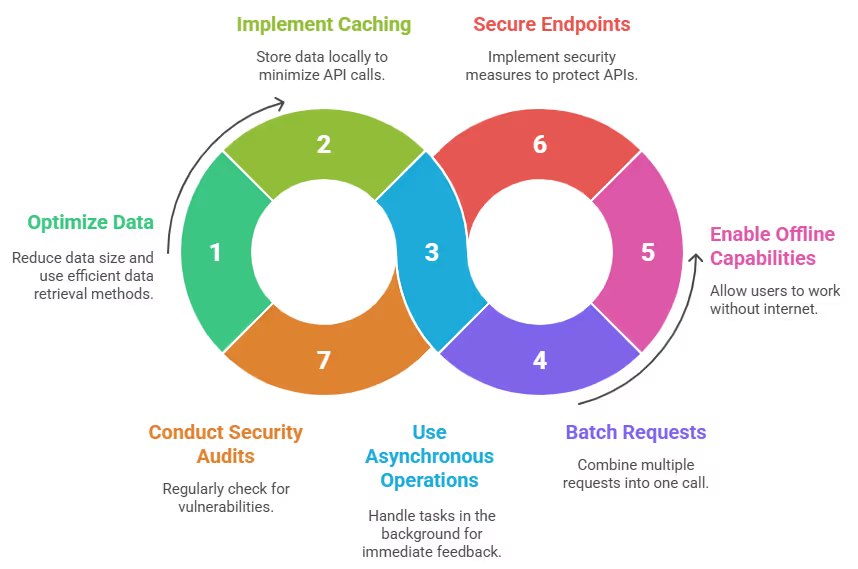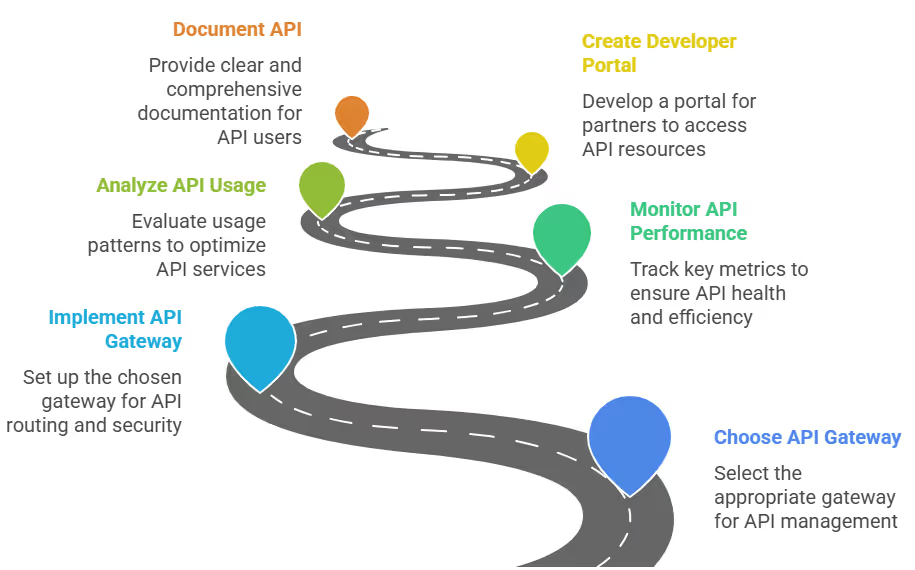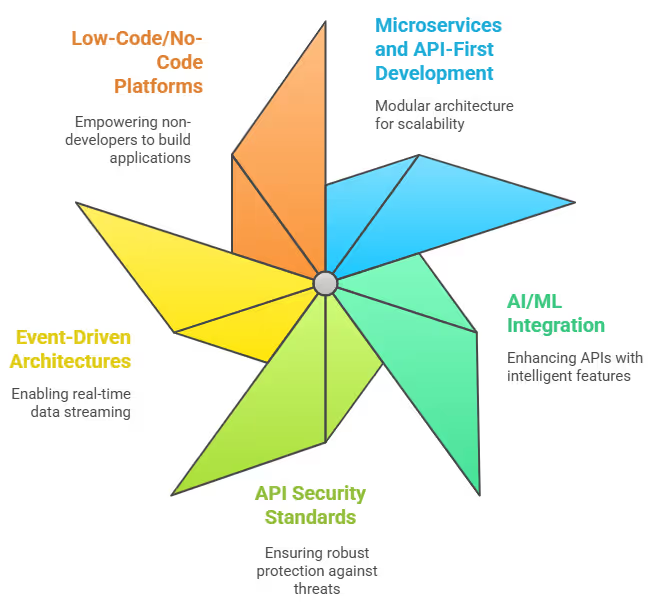B2B API Management: Developer's Guide for Seamless Integrations

B2B API Management: A Software Developer's Blueprint for Seamless Integration and Mobile App Excellence
Seven years ago, when I started as a software developer, enterprise integration felt like a tangled mess of custom scripts. Now, after designing and deploying over 50 API-driven solutions, I see how Application Programming Interfaces (APIs) changed B2B interactions. APIs power everything from supply chain management to real-time financial data exchange. They form the core of today's digital systems.
Businesses worldwide use APIs not just for internal work but also as products. This creates new income and helps partners innovate. My work, especially building scalable solutions for SaaS companies and integrating systems for clients in North America and Europe, showed me how much robust b2b api management matters. This post explores b2b api management. It gives a developer's view on building good strategies, securing endpoints, and handling the specific challenges of mobile app APIs.
B2B API management helps businesses integrate securely, scale effectively, and exchange data smoothly.
B2B API Management: More Than Just Writing Code
Many developers think an API is just a way to use or offer endpoints. But in the B2B world, b2b api management covers much more. It includes the entire process: design, development, deployment, security, versioning, monitoring, and removal. It is the plan that lets two different businesses talk and do business digitally, reliably, and safely.
My first B2B integration project involved exchanging inventory data with a dozen suppliers. We lacked a central API management plan. Each integration became a custom job, leading to problems with consistency, security risks, and a maintenance nightmare.
This experience taught me that b2b api management success needs more than just functional code; it requires clear rules, standards, and a good way to operate.
Why B2B APIs Are Important for Today's Businesses
B2B APIs are like digital handshakes between companies. They automate tasks, sync data in real time, and power shared platforms. Think of a logistics company in California using a shipping carrier’s API for live tracking updates.
Or a financial institution in London processing payments with a payment gateway API. These integrations are not just convenient; they are essential for staying competitive.
They cut down manual work, reduce errors, and speed up business processes. This saves money and makes customers happier.
From a developer's view, well-managed B2B APIs mean less time on custom integration and more time on new ideas.
They offer a standard way to access services. This lets us build new features and products faster by using what partners already offer.
Developers Drive B2B API Success
As developers, we lead B2B API implementation. Our jobs go beyond coding.
We play a key role in:
- API Design: We make sure APIs are easy to use, consistent, and follow industry best practices (like RESTful rules, OpenAPI specifications).
- Security Setup: We add strong authentication (OAuth 2.0, API keys), authorization, and encryption.
- Performance Improvement: We design APIs to be fast, efficient, and able to handle many requests.
- Documentation: We create clear, full documentation. This helps partner developers easily understand and use our APIs.
- Fixing Problems and Support: We are the first to help when integration issues come up.
My experience shows that getting developers involved early in b2b api strategy talks leads to more practical, strong, and easy-to-maintain solutions.
We understand the technical details and possible problems better than anyone.
Building a Strong B2B API Strategy
A clear b2b api strategy is the foundation for successful digital partnerships. It explains how to design, build, deploy, and manage APIs to meet business goals.
Without it, you risk creating a messy, unsafe, and unstable API environment.
In one project for a big e-commerce platform, not having a clear strategy caused different teams to build similar API functions. This created duplicate work and confusion for outside partners.
It was a costly lesson that showed how important a central strategy is.

Design Rules for Easy Connections
Easy connections are vital for B2B APIs. Partners use different technologies, so your API must work and be clear across various systems.
Key design rules include:
- Standardization: Follow widely accepted standards like REST, GraphQL, or gRPC. JSON and XML are common for data formats.
- Consistency: Keep naming, error handling, and authentication methods the same across all your APIs.
- Discoverability: Make sure partners can easily find your APIs through well-organized developer portals and clear documentation. Tools like Swagger UI are very helpful here.
- Modularity: Design APIs as small, separate services (microservices). You can develop, deploy, and scale these independently.
- Idempotency: For operations that change data, ensure that making the same request multiple times has the same result as making it once. This is crucial for reliable integrations.
Security First: Protecting Your B2B Data
Security is not an afterthought; it is a core part of your b2b api strategy. B2B APIs often handle sensitive data, making them prime targets for cyberattacks.
As a developer, I focus on putting in multiple layers of security:
- Authentication:
- OAuth 2.0: This is the industry standard for giving third-party applications access to user data without sharing credentials.
- API Keys: Simple for basic uses, but less secure than OAuth for sensitive data. Often used with IP whitelisting.
- Mutual TLS (mTLS): This provides strong authentication by checking both the client and server using digital certificates.
- Authorization: Set up strict access control. Make sure authenticated users or applications can only reach the resources they have permission for. Role-Based Access Control (RBAC) is a common method.
- Encryption: Use HTTPS/TLS for all API communication to encrypt data as it travels. Also, consider encrypting sensitive data when it is stored.
- Input Validation: Clean and check all input to stop attacks like SQL injection or XSS.
- Rate Limiting & Throttling: Protect your APIs from misuse and denial-of-service (DoS) attacks. Limit how many requests a client can make in a certain time.
- Threat Protection: Use Web Application Firewalls (WAFs) and API gateways that can detect threats.
Managing Versions and API Lifecycles
APIs change, and handling these changes without breaking existing connections is a big task.
A clear versioning plan is essential.
Common ways to do this include:
- URI Versioning: Put the version number in the URL (e.g.,
/api/v1/products). - Header Versioning: Specify the version in a custom HTTP header.
- Content Negotiation: Use the
Acceptheader to ask for a specific media type and version.
I prefer URI versioning for big changes. It is clear and easy for users to understand. For small, compatible changes, I suggest no version change, or using a "patch" version in the header.
A strong lifecycle management plan also includes:
- Deprecation Policy: Clearly tell partners when older API versions will stop working. Give them plenty of time to switch.
- Backward Compatibility: Try to keep older versions working as much as possible. This minimizes problems for current users.
- Change Logs: Keep detailed records of changes for each API version.
Mobile App APIs: Essential for B2B Systems
In today's mobile world, the mobile app api is not just nice to have; it is a must for B2B interactions. Whether a field service technician updates work orders on a tablet, a sales rep checks CRM data on their phone, or a delivery driver confirms a drop-off, mobile apps depend on strong and efficient APIs.
From a developer's view, building an api mobile app needs special thought. Mobile environments have unique limits: network delays, battery use, and unstable connections.
These differ from traditional web or server-to-server integrations.

Making Mobile APIs Fast and User-Friendly
Mobile users expect quick responses. A slow mobile app api can frustrate users and make them leave the app.
Ways to make it faster include:
- Optimizing Data:
- Send Less Data: Only send what is needed. Use methods like partial responses or GraphQL to let clients ask for specific data fields.
- Compression: Use GZIP compression for API responses to make data smaller.
- Caching: Use caching on both the mobile app and server to reduce repeated API calls.
- Asynchronous Operations: Design APIs to handle long tasks in the background. This gives immediate feedback to the mobile app while the task finishes.
- Batching: Let mobile apps send multiple requests in one API call. This reduces network overhead.
- Offline Capabilities: For important B2B mobile apps, design APIs that can sync data offline. This lets users work even without internet.
Securing Mobile API Endpoints
Securing a mobile api creates special challenges because mobile apps run on the client side.
Mobile apps are more open to reverse engineering and tampering than server-side applications.
- Token-Based Authentication: Use short-lived access tokens (like JWTs) with refresh tokens. This limits how long a compromised token can be used.
- Certificate Pinning: Embed your server's public key certificate directly in the mobile app. This stops man-in-the-middle attacks by ensuring the app only talks to your real server.
- Obfuscation & Tamper Detection: Make your mobile app's code harder to understand and add ways to detect tampering. This makes reverse engineering tougher.
- Secure Data Storage: Make sure sensitive data saved on the device is encrypted.
- API Gateway Protection: Use an API gateway to enforce security rules, check tokens, and block bad requests before they reach your backend.
- Regular Security Audits: Do penetration testing and security checks specifically for your mobile API endpoints.
Real-world Examples: B2B Mobile Integrations
Imagine a healthcare provider using a mobile api to let doctors securely access patient records from their tablets during rounds. The API must handle sensitive patient data very securely and give quick access to vital information. Another example is a manufacturing company using a mobile app to track production line numbers in real time. It pulls data from various IoT sensors using a dedicated mobile api. These situations show how much high performance, reliability, and strict security matter.
Let's look at more real-world examples where a strong mobile app api makes a big difference for businesses:
- Logistics and Supply Chain: Delivery drivers use mobile app APIs to update package status, capture proof of delivery, and get real-time route changes. Warehouse staff use them to scan inventory, manage stock levels, and fulfill orders directly from their handheld devices. This speeds up operations and improves accuracy.
- Field Service Management: Technicians in the field rely on mobile APIs to access client information, view equipment manuals, order replacement parts, and submit service reports. This reduces paperwork and ensures they have the right information to complete jobs efficiently.
- Retail and Sales: Sales associates use mobile APIs to check product availability across stores, process customer orders on the spot, and access detailed customer purchase histories. This helps them provide better service and close sales faster.
- Financial Services: Mobile banking apps for business clients use mobile APIs to allow secure fund transfers, check account balances, approve payments, and even apply for loans directly from their phones. Loan officers can process applications and verify documents while meeting clients.
- Construction and Project Management: Site supervisors use mobile APIs to track project progress, manage daily logs, report safety incidents, and communicate with teams. This keeps projects on schedule and improves on-site decision-making.
These examples show that a well-designed mobile app api is not just about convenience. It directly impacts operational efficiency, data accuracy, and the ability of businesses to serve their customers better, no matter where they are.
From Design to Deployment: Building an Mobile App API
Building an api mobile app well needs careful thought about infrastructure, tools, and how you operate.
As a developer, I find that a good API gateway and strong monitoring are essential.

Choosing the Right API Gateway
An API gateway is the single entry point for all API calls. It handles routing, security, rate limiting, caching, and analytics. For mobile api implementations, it is especially important. It takes common tasks away from your backend services and provides a consistent way to connect.
Popular API gateways include:
- Google Apigee: This is a full, enterprise-level API management platform. It offers advanced analytics, security, and developer portal features. It works great for large B2B integrations. Learn more about Google Apigee.
- Kong Gateway: An open-source, lightweight, and very fast API gateway. You can extend it with plugins. It is perfect for microservices and teams that prefer to host their own solutions or want more control. Explore Kong Gateway.
- Azure API Management / AWS API Gateway: These are cloud-native solutions. They work smoothly with their cloud systems, offering scalability and managed services. Check out Azure API Management and AWS API Gateway.
My choice often depends on the project's size, existing cloud setup, and budget. For a complex b2b api strategy with many partners and high traffic, Apigee offers unmatched features. For a more agile, microservices-focused approach, Kong is often a strong choice.
Monitoring and Analytics for Mobile APIs
Once your mobile api is live, constant monitoring is crucial. You need to know if your API works well, if there are errors, and how partners use it.
Key things to track include:
- Response Times: How long different endpoints take to respond.
- Error Rates: HTTP status codes (e.g., 4xx client errors, 5xx server errors).
- Throughput: How many requests per second.
- Usage Patterns: Which endpoints are most popular, who uses them most.
- Resource Use: CPU, memory, network use of your API servers.
Tools like Datadog, New Relic, or cloud-native monitoring services (e.g., AWS CloudWatch, Azure Monitor) give you the visibility you need. They help you find and fix problems before they get big. For mobile APIs, tracking network conditions and device types also gives valuable insights.
Developer Portals and Documentation
A well-designed developer portal is what partners see first for your b2b api management strategy. It is where partners find your APIs, read documentation, manage their applications, and get help. For a mobile app api, clear examples and SDKs for popular mobile platforms (iOS, Android) are essential.
Good documentation should include:
- API Reference: Detailed descriptions of endpoints, request/response formats, authentication methods, and error codes.
- Tutorials & Guides: Step-by-step instructions for common tasks.
- SDKs & Code Samples: Ready-to-use libraries and example code in various programming languages.
- FAQs & Support Resources: Answers to common questions and ways to get help.
I have spent many hours fixing integrations just because the documentation was unclear or old. Investing in clear, current documentation saves time on support and helps partners get started faster.
Preparing Your B2B Mobile App API
The world of B2B integration changes constantly. To keep your mobile api and overall b2b api strategy relevant and effective, you must look at new trends and technologies.

Microservices and API-First Development
Moving to microservices architectures naturally fits an API-first approach. Here, every service offers its functions through clear APIs. This makes things modular, allows independent deployment, and helps with scaling.
These benefits are especially useful for complex B2B systems and high-demand mobile app api integrations.
My team recently broke down a large, single application into microservices. The improvement in deployment speed and how we isolated faults for our mobile api was amazing.
Each service could be updated without affecting the whole system.
- Benefits for Mobile: Microservices mean your mobile app API can pull data from many small, independent services. If one service has an issue, it does not bring down the entire api mobile app. This leads to more reliable and faster mobile experiences. You can also update specific parts of your mobile app's backend without a full redeployment.
- Challenges and Solutions: While microservices offer great benefits, they also bring challenges like managing distributed data and tracing requests across many services. Tools like service meshes (Istio, Linkerd) help manage traffic, security, and observability in these complex environments, making your mobile api more robust.
AI/ML Integration with B2B APIs
Artificial Intelligence and Machine Learning increasingly integrate into B2B APIs.
This can happen in several ways:
- Smart Automation: APIs use AI to automate complex decisions. Examples include fraud detection in financial transactions or predicting maintenance needs in industrial IoT.
- Better Data Insights: APIs provide richer data by using ML models. This includes checking customer feedback for sentiment or finding unusual patterns in sensor data.
- Conversational Interfaces: APIs power chatbots and virtual assistants that talk to B2B systems.
As a developer, understanding how to use and offer AI/ML models through APIs is becoming a key skill for building the next generation of B2B solutions.
- Practical AI/ML API Use: Imagine a mobile app API for a B2B e-commerce platform. It could use AI to offer personalized product recommendations to business buyers based on their past orders. Or a financial api mobile app could use ML to detect unusual transaction patterns in real time, flagging potential fraud instantly. Developers expose these AI/ML models as API endpoints, making intelligent features available to any connected application, including your mobile app api.
- Generative AI and APIs: The rise of generative AI means APIs can now create content, summarize documents, or even generate code snippets. B2B applications can use these APIs to automate report generation, create marketing content, or provide advanced customer support through conversational AI, all accessible via your b2b api management layer.
API Security Standards Keep Changing
API security is a moving target. New threats appear, and new best practices develop. Staying updated on standards like FAPI (Financial-grade API) for very sensitive data, or new ways to authenticate, is crucial. The move towards Zero Trust systems also affects b2b api management.
It stresses constant checking and giving only the minimum access needed for every interaction.
- Evolving Threats: As APIs become more central, they face new threats like API abuse, data breaches, and sophisticated bot attacks. Your b2b api strategy must include continuous API security testing, such as Dynamic Application Security Testing (DAST) and Static Application Security Testing (SAST), along with regular penetration testing.
- Zero Trust in Practice: For your mobile api, Zero Trust means that every request, even from inside your network, must be verified. This involves continuous authentication and authorization checks. API gateways play a crucial role here, enforcing these policies at the edge.
- API Threat Intelligence: Staying informed about the latest API vulnerabilities and attack vectors is vital. Integrating API threat intelligence feeds into your security operations helps you proactively defend your mobile app api and other B2B integrations.
Event-Driven Architectures and Real-time APIs
Beyond traditional request-response APIs, event-driven architectures are gaining importance. Here, APIs trigger events that other systems can subscribe to.
This allows for real-time data streaming and immediate reactions to changes.
- Real-time Mobile Updates: For a mobile app api, this means instant notifications for inventory changes, order updates, or critical alerts. Technologies like Apache Kafka or RabbitMQ, exposed through APIs, enable these real-time data flows, making your api mobile app highly responsive and dynamic.
- This is especially useful for logistics, financial trading, or IoT monitoring.
Low-Code/No-Code Platforms and API Enablement
The rise of low-code and no-code platforms allows business users, not just developers, to build applications.
APIs are the backbone that makes this possible.
- Empowering Citizen Developers: A well-managed b2b api management system provides secure and easy-to-consume APIs.
- These APIs enable citizen developers to integrate your business services into their own low-code applications.
- This speeds up internal automation and innovation without needing deep coding skills, extending the reach and value of your b2b api strategy.
Comparing Top API Management Platforms
Choosing the right platform is a vital part of your b2b api strategy.
Here is a comparison of some leading API management solutions.
Moving Forward with Your APIs
By prioritizing robust design principles, implementing multi-layered security, and leveraging powerful API management platforms, developers can build the resilient digital bridges that drive modern business. The future of B2B interactions is undeniably API-driven, with emerging trends like microservices and AI integration continually reshaping our approach.
Embrace these challenges, and you will not only build great software but also contribute to the strategic success of your organization and its partners.

